What gives water its colour?
How the heck can a lake be pink? Are different coloured waters better for marine life? Can you make bread from rock flour? This is your reminder to hydrate.
Welcome to all the new Amateurs who joined ranks this week! One of the best parts of asking the silly questions is all the other unexpected nuggets that emerge from the answers. My job is to find the nuggets; your job is to figure out how they fit with your perspective in this world. Plus I’m nosy and I want to know what you think, so please comment, share widely, and reply directly to me via email to taco ‘bout it.
The Amateurist is still getting started, so all of you fine folks on the free list will continue to get full access to the archives and every new post for the time being.
HOWEVER. This is your periodic reminder that there’s a paid subscription option if you care to dispatch five bucks a month (or a bargain $55/year) toward learning something every week! It helps to keep some of my time free from client work to focus on this, the thing I love to do.
Every Amateur who signs up for a paid subscription between now and September 30 (inclusive) will receive a super cool forever discount PLUS the option to submit a topic of their choice for their own mini-post this fall. It’s like asking Google, but way slower!
That’s enough business for now. Onward, nerds!
Take a deep breath, and imagine yourself in nature. It smells like fresh mountain air, maybe a sea breeze. A gentle lapping of water on the shore.
What sort of water do you see? Maybe milky blue glacial waters between two mountains, or a dock floating on a green lake? Transparent ocean lagoons where you can see the coral and the fish? Otherworldly rose-coloured ponds? It sometimes seems like the world enjoys stupefying us with its choices. Honestly, we’re probably easy targets.
But how does water even change colour? Why are glacial lakes blue like that? Does a crystal clear lake mean something? Rock flour bread????
Put on your water wings, peeps, we’re going swimming and getting to the bottom of it.

For those of us who are several (!) years out of Grade 9 science, let’s review the basics:
All water appears clear to the naked eye in small quantities. Water colour is caused by light being selectively absorbed and scattered through it like a prism. Good? Good.
Most lakes and oceans reflect the colour of the sky on the surface. Below the reflection, water likes to absorb yellow, orange, and red wavelengths and generally reflects the blues and violets. We don’t actually see the wavelengths that are absorbed! That’s why the biggest bodies of water appear blue, almost regardless of composition. It’s the stuff floating around (hold on, we’re getting to that!) that changes how the eye interprets the light.
Don’t worry, there won’t be a test. Probably.
Do you ever feel an existential wave crash over you when you learn stuff about the vastness of the universe or how the Earth was formed? Like everything is so much bigger than we can ever imagine and every single force in existence is beyond our control? Just me? Fine.
The wormhole I fell into this time was around plate tectonics and how every minute of every day there are entire continents smashing into one another with quadrillions of tons of force, and breaks in that tension is what creates earthquakes and mountains and fundamentally changes how our planet is.
For billions of years, the planet has existed in flux with plate migration and ice ages causing sublimation here, mountain ranges there, and tons of wacky landscape features that feel inexplicable.
The colour of water, I know, we’re getting there.
One of the key players in surface geological changes is [angels singing] the glacier and their sneaky way of turning any given chunk of land into a giant I WAS HERE sign.
Glacial lakes are preeeeeeetty much the coolest visible reminder of geological history, since they were formed by glaciers scraping their way to and fro during various ice ages, carving out huge swaths of land and leaving them full of meltwater.
Check this out, it’s the prehistoric Lake Agassiz, smack in the middle of the continent. Once upon a time it was the world’s largest glacial lake and held more water than every other lake in the world combined. Nowadays, the remnants of Agassiz are Lake Winnipeg, Lake of the Woods, and many of the other reservoirs that dot the region.

Here’s where our investigation begins. Exhibit A: icy blue glacial lakes.
Glacial melt doesn’t carry many colourful characteristics on its own. It’s mostly a neutral blueish and can get cloudy with brown or green sediment, especially in deeper basins like the Great Lakes. The most striking difference between the watery remnants of ancient ice sheets and the ones still receiving icy runoff from mountain glaciers is unequivocally [more angels singing] THE COLOUR!!!!
No offence to the east, but if we’re talking about the most spectacular blue lakes, the west is the place to be. (Not because of bias, because of science!)
Take Alberta’s Lake Louise. Stunning, iconic, and perfectly photogenic with the milky blue-green waters:
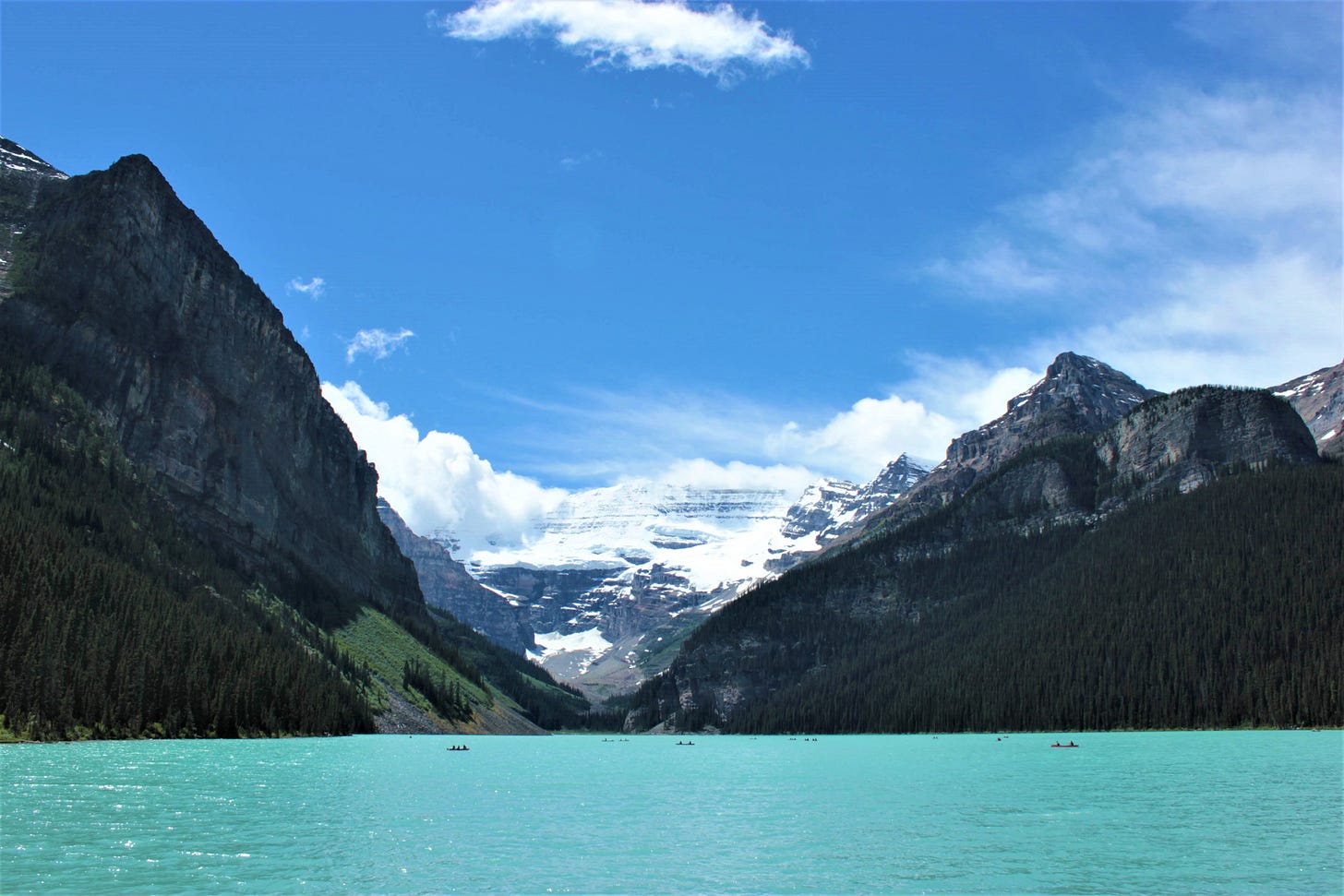
What makes this glacial lake different from its easterly cousins is what’s going on underneath. The Rockies are relatively young in geological age (55-80 million years old). They formed as a result of tectonic plate collisions between the oceanic crust and the continent - when the pressurized subduction got to be too much, something had to give. The pressure pushed the land up, forming mountains!

All that to say, the environment is perfect for some wild glacial lake action since the mountains and glaciers are relatively young, active, and liable to have lots of fresh rocks for glaciers to erode. And that’s when the magic happens.
So, glacial melt is basically colourless but skewing blue, remember, based on how deep the water gets and how much light it can absorb. The brilliant blue of Lake Louise is a product of that inherent blue, plus the addition of floating sediment thanks to all the glacier activity going on in the Rockies.
As glaciers advance and retreat, the rocks underneath expand and contract and end up grinding themselves into a super fine powder called rock flour. Paints a picture, right? You can see here where the grey, milky water flows into the lake:
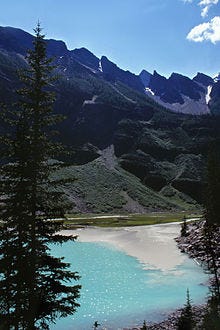
Sidenote: you can’t bake with rock flour, but the U.S. Department of Agriculture is investigating it as an additive to help combat soil depletion because of its rich mineral composition. So I guess you could technically bake with it…twice removed…
BACK ON TRACK, HERE WE GO
Glacial water is so bright turquoise because the suspended rock flour reflects and scatters more colours than water alone does. These lakes are fairly clear and have relatively shallow basins, which is the perfect combination for rock flour to work its colour magic. The sun’s wavelengths hit it just right and absorb just enough but not too much. If Goldilocks was in the room, you know what she would do.
Turquoise lakes don’t impact our lives very much, other than putting on a spectacular show. Fodder for social media likes, for sure (people loooove this stuff), but our access to filtration and agricultural technologies tend to keep potential hazards at bay. For local ecosystems, though, the creamy glacial milk (I didn’t make that up) doesn’t deliver very many nutritional benefits at all.
As I was doing research for this edition, I couldn’t help but wonder if a shiny turquoise lake was intrinsically healthier than say, a murky brown one. Crystalline waters have a reputation for being pristine, don’t they? Turns out glacial milk is not the oasis it appears to be.
According to a 2012 study, glacial rock flour contributes to a marine environment that’s just not conducive to very much life. Plankton, algae, and many fish populations need generous amounts of key elements remain viable. Lakes like this tend to be oligotrophic; they lack the nitrates, iron, phosphates, and carbon sources to sustain nutrient levels that would support most aquatic vegetation.
The exception to the rule is fish! You might find cold water-adapted fish like lake trout cruising the cool, oxygen-rich depths of lakes when the rock flour starts to peter out and settle on the bottom. It’s at this stage that the water turns from opaque to crystal clear. You’ll notice that there’s little to no veg visible down there. These waters might be less silty than others, but that’s no reason to suggest that the biosphere is well-supported. Quite the opposite, in fact!
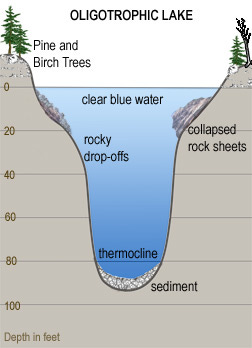
Verdict: photogenic but fairly empty.
Exhibit B: Silty lakes and rivers
In older lakes no longer connected to the glaciers who created them, like the Great Lakes, floating sediment and organic matter actually help to support large quantities of marine flora and fauna. The absence of rock flour here helps to stabilize the ecosystems by not having nutrients and sunlight filtered away by the sediment. With more access to greenery along less mountainous shorelines, the lifecycle of entire ecosystems perpetuate one another.
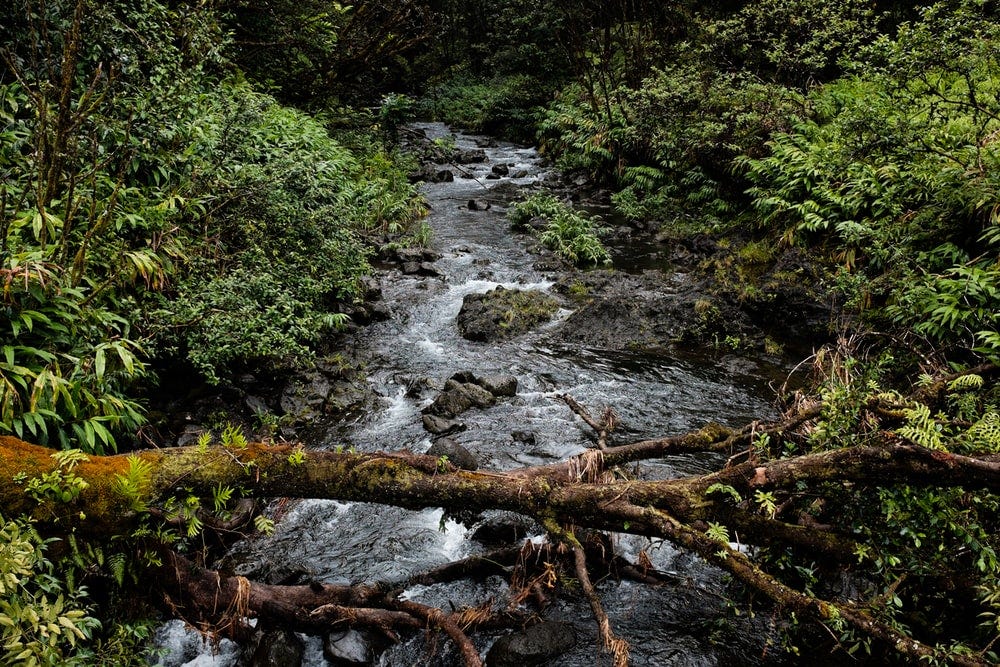
Microorganisms in the water have enough nutrients to live while nearby vegetation sheds leaves and branches into the water. Algae, mosses, and freshwater seaweeds have organic matter to keep their engines running, and all of a sudden bugs and birds are at the party and fish have plenty of food and just the right amount of sunlight and oxygen. Just like that, the silty green lake that isn’t as beautiful as the glacial lake has the most action and the best prospects.
Take that, glaciers.
Verdict: Unpretentious yet successful.
As for the wild world of pink lakes, the internet really came to my rescue. My closest guess as to how they’re even a thing was that some kind of bacteria caused the colour change. Otherwise it felt like a curious but unfortunate side-effect of humans being humans.
I once learned about a specific kind of cheesemaking (washed-rind cheeses) that involves a high-salinity wash to remove bacteria from the rind while it’s aging, and those rinds would always turn a pinky-orange colour because one pesky type of bacteria actually thrived under those conditions.
It turns out I was almost right!
Here’s Lake Hillier in Australia, looking great in pastels:
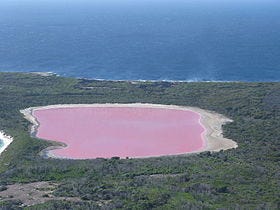
The orange/pink colour of salt lakes across the world is caused by the green alga Dunaliella salina and the archaea Halobacterium cutirubrum.
Dunaliella salina is the most salt tolerant alga known and can grow in salinity as high as 35% NaCl (in comparison to seawater, which contains approximately 3% NaCl).
At high salinity, temperature and light, this alga accumulates the red carotenoid pigment, beta-carotene. This is the same pigment that gives carrots, which contain 0.3% of beta-carotene, their colour. Concentrations as high as 14% of the dry weight can occur in Dunaliella salina, which is the highest in any organism. The beta-carotene protects the alga against damage from high light, coating the green chlorophyll and giving the alga an orange/red colour.
Dunaliella salina is found in salt lakes around the world including Antarctica, Chile, US, China, Tibet, France, South Africa, and in Western Australia off the coast of Cape Arid, and Lake Hillier. The alga was named after Michel Félix Dunal who first recognised the red colour of certain salt lakes in France was due to an organism.
The archaea Halobacterium cutirubrum is pink in colour and generally grows within the salt crust on the bottom of the lake. The exact colour of the lake depends on the balance between Dunaliella salina and Halobacterium cutirubrum, with salt concentration having a direct impact.
There you have it, a fabulous type of algae that thrives under salty conditions and uses beta-carotene to guard against UV rays. I wish I had that kind of skincare.
Some pink lakes, like Hillier, are a product of microorganisms, though there is still evidence that others are affected by runoff from their environments. Dusty Rose Lake in B.C. is completely devoid of oxygen and likely turned pink due to other environmental factors. (Reading between the lines here, it looks like soil and groundwater pollution might have something to do with it; water can take on a reddish hue if there’s a surplus of iron and other mineral deposits nearby. Boooooooo.)
That’s all for this one! Go drink a glass of water.
Your friend, Nat



